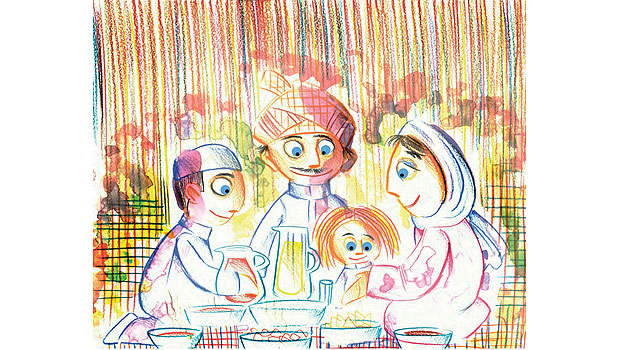On the day of Eid, Muslims gather early in the morning in outdoor locations and mosques to perform the Eid prayer called Al-Mashhad. In Saudi Arabia, people usually gather before the prayer to give well wishes and greet each other for the holiday and exchange presents and Eidiyah (money given as an Eid present).
On Eid Al-Fitr, Muslims are allowed to have food in the morning and practice their old habits of eating breakfast and drinking coffee.
“Saudis usually gather with their friends and family for the big Eid breakfast,” said 56-year-old Abdulrahman Al-Nasser. “My family and I get together at my grandfather’s house to have our traditional Eid breakfast: A dining table filled with different kinds of traditional home cooked meals.”
Hejazi traditional home cooked meal recipes are being passed from one generation to the next to keep them alive. Seventy-eight-year-old Um Tariq has been hosting Eid for many years, cooking every year for her family. She shared her home cooking recipes with us.
“Saudi Eid breakfasts are usually served with items on a variety of small plates and bowls,” she explained. According to Um Tariq, you will always find small dishes that contain different types of Tateema (different types of olives, cheese, honey, jam and bread that are placed on different small plates).
One of the famous Eid dishes is the Debyaza (apricot pudding with nuts). One will need to prepare this dish three days before Eid in order for it to thicken and become sweeter. To make Debyaza, you will need apricot paste, dried dates, dried apricot, raisins and some nuts.
“Start by slightly frying the nuts and raisins until they turn a golden color,” explained Um Tariq. “Then, put them aside to use in the future. Marinate the dried dates and apricot in hot water and add sugar. Sift the mixture and put it on the side. Then, bring a big cooking pot and add the apricot paste to hot water. Keep stirring it on the stove until it turns to a thick liquid. Add the nuts and dried apricot and dates to the melted paste and keep stirring. Finally, take it off the stove and wait for it cool down. Separate it to small containers and keep it in the fridge to serve cold.”
On the other hand, Shakshookah, a Saudi variation of scrambled eggs mixed with vegetables, is made minutes before Eid breakfast, as it needs to be served hot. For this dish, you will need vegetable oil, one chopped onion, tomato cubes, eggs, colored bell peppers, tomato paste, chopped basil, a small amount of chilli peppers and seasonings. (Um Tariq advises that you serve this dish with warm pita bread.)
“Heat the oil in a frying pan, then add the onion. Sauté until the onion is golden clear, then turn the heat down to medium. Add the tomatoes, chilli peppers, tomato paste and bell peppers and mix well. Cover the pan and simmer the mixture over low heat for 15 minutes,” said Um Tariq. “Add basil and seasonings and mix together. Then, gently crack the eggs without breaking the yolks and drop them into the mixture. Cover the pan again and continue cooking the mixture for another five minutes until the eggs set.” (She advises that you serve this dish with warm pita bread.)
Another famous Hejazi dish is Kebdah (lamb liver with tomatoes). This dish is prepared with fresh liver, as Islam urges Muslims to slaughter lamb or sheep at Eid to donate and distribute to poor people so they can celebrate Eid with others and eat meat.
Um Tariq’s recipe contains chopped onions, diced tomatoes, minced garlic, diced fresh lamb liver, black pepper, Maggi cube, chopped coriander and vegetable oil.
“Sauté the onion in oil over medium heat for two minutes. Then, add the garlic and keep mixing for seven minutes. Add the tomatoes, black pepper and Maggi cube and stir for 10 minutes. Add the liver and cook for another two to four minutes, stirring continually until the liver is only pink from the inside (cook for an additional two to three minutes if you want it to be totally cooked),” explained Um Tariq, adding that you should serve it immediately and garnish it with coriander.
Some Saudi families mix genders while dining while others prepare two different tables for men and women. On the other hand, a traditional Saudi Eid breakfast would be served on the floor on a plastic sheet (sold in large rolls and found in supermarkets throughout the Kingdom). A variety of plates and bowls are laid out in an eye-catching and appetizing manner along with coffee and tea. After breakfast, families start visiting neighbors and friends to wish them a happy Eid.










